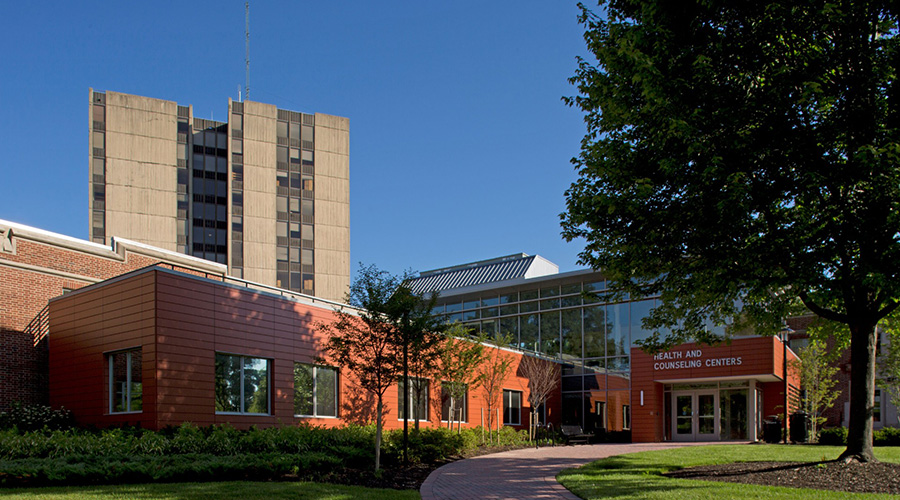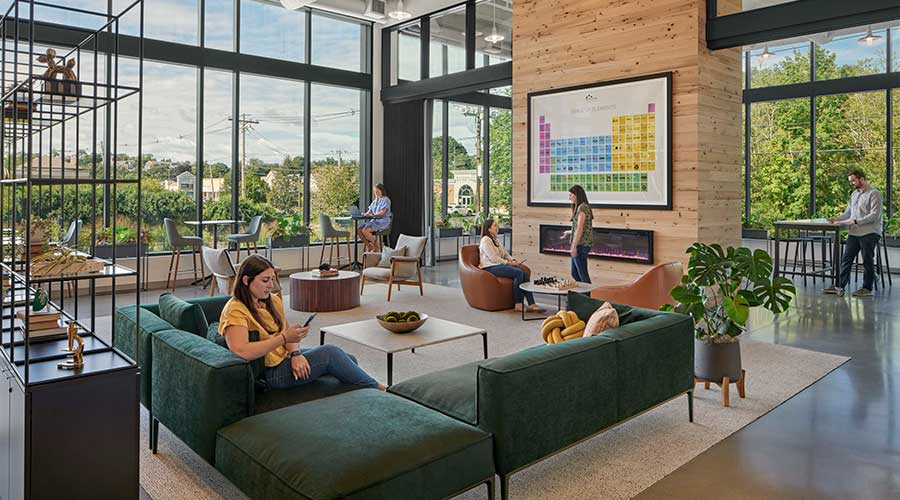A Clean Slate
As it builds its first campus in 35 years, the University of California is using sustainability and smart buildings to create a living laboratory for students
It’s no secret that energy-efficiency improvements in California buildings helped the state cope with electricity shortages a few years ago. It’s also no secret that California has some of the country’s most stringent air-quality standards and is in the midst of fending off water shortages through tough conservation measures.
So it should come as no surprise that when the Golden State’s university system had an opportunity to begin with a clean slate — with the system’s first new campus in 35 years — officials incorporated design principles and environmental goals that will set a new standard for how to build green college campuses.
Ambitious environmental goals are only one example of a pervasive philosophy that is shaping the character of the University of California-Merced, the 10th campus in the state’s system. The university is designing both a campus and an academic atmosphere that looks to the future of the area and the world.
That the University of California had the opportunity to begin anew is partly the result of the site on which the new campus is being built: a 7,000 acre parcel of pristine land located in the San Joaquin Valley — one of the world’s most agriculturally fertile areas. Thanks to an $11 million grant from the David and Lucille Packard Foundation, which enabled the University of California system to acquire the land, the campus is confined neither by city borders nor ocean coasts.
In fact, the only thing muddying the waters over Merced’s future is the political and economic realities of the state’s budget. In the face of a $38 billion deficit, the state Senate approved a budget in late July containing $11 million in cuts. That budget, which is subject to approval by the state’s General Assembly and the governor, would slash funding for the state’s universities by 1.6 percent.
It’s unclear exactly how those cuts will affect the university system’s operating budget, or if they’ll even survive the General Assembly. Final approval of a state spending plan might not come until the end of August. What is clear, however, is that construction is going to continue on the Merced campus.
The administration’s aim is to have every major building on the Merced campus rated at the Silver level through the U.S. Green Building Council’s LEED
rating system. But even with such ambitious aims, says Karl Brown, deputy director of UC’s California Institute for Energy Efficiency and consultant to the University of California for the Merced campus, none of the energy-efficiency technologies used on the campus are revolutionary.
“What’s being done at Merced is generally doable by most universities,” Brown says.
One advantage the Merced campus has to create the type of campus it wants is space. Although not necessarily a benefit when it comes to energy efficiency, space does give officials overseeing the project greater latitude to create a community around the campus that helps support the college’s mission.
Adjacent to campus, for example, is enough vacant land to allow the university to build a mixed-use development. When complete, that planned development with an expected population of 30,000 will contain single- and multi-family residences, half of which will be reserved for students and faculty. It will also contain commercial offices, retail shops and a high school.
James Grant, director of communications for the university system, says that strategy is radically different than the approach taken at campuses in Los Angeles and Berkeley. At the time the state built those two campuses, little surrounded the academic buildings. Over time, however, the cities grew up around the campus and demand for housing rose. The result was that many students and faculty were essentially priced out of the residential market.
That’s not the only way that the university is taking a long-term view of the land it now owns. More than 5,000 acres of the site have been designated as a conservation preserve that will protect sensitive vernal pool habitats in perpetuity. Of the remaining 2,000 acres, which will be devoted to the new campus, 750 acres will be left undeveloped as a natural preserve because of the importance of its vernal pool habitat.
To be sure, Merced will be a campus where students and faculty will be experimenting — in visible ways — with how to live and work in a sustainable setting. When the first 600,000 square feet of buildings open in time for classes in the fall of 2004, the campus will be complete with bike paths and showers in academic buildings.
Patti Istas, spokeswoman for the Merced campus, says the bike paths are designed to mitigate campus traffic. “We want to improve the air quality, and that is partly done by encouraging people to ride their bikes.”
According to Istas, the campus also will conserve water by using low-flow plumbing fixtures on toilets, showerheads and faucets. Campus landscaping will use native plants that do not require much irrigation, and provisions are being made for future use of recycled water.
The first phase of Merced’s construction includes three academic buildings and student dining, housing wellness and recreation centers.
Many of the tangibles at Merced are still unknown. After all, the long-range development plans anticipate that enrollment at UC-Merced will top 25,000 students, but that’s not expected until 2030. The school is scheduled to open for classes in September 2004 with an enrollment of 1,000, although the outcome of the final state budget could change the opening date.
How then does a school system plan for a new, sustainable campus from the ground up without previous experience? One step the university has taken is to incorporate proven energy-efficient technologies in the buildings and infrastructure. Those measures include:
- High-performance glazing.
- Sun shading for building exteriors.
- High-quality lighting with low power density.
- Low pressure-drop design of laboratory air systems.
- Indirect evaporative precooling of outside air for laboratory systems.
- Laboratory process and refrigeration load rejection to the indirect evaporative system.
- Some HVAC systems without reheat.
- Individual HVAC control zones for some personal offices.
- High chiller plant efficiency.
- Thermal energy storage units.
- Enhanced energy-performance monitoring.
Merced’s most daunting challenge — one expected to become its crowning achievement — isn’t in the individual components or in any single design element. Rather, it’s in the total energy reductions that the Merced campus is expected to make.
Energy Use Goals
Concern over energy consumption ranks high on the list of Merced’s sustainability goals. For the purposes of creating efficiency goals that Merced can measure, two guiding points have been used in the planning process: California’s Title 24 standards and benchmarks from other campuses in the University of California system.
The campus currently aims to best Title 24’s current minimum standards by 20 percent or more with the first buildings being constructed. Officials chose 20 percent as the initial goal because that’s the performance level sometimes being achieved by other campuses.
Although 20 percent is the initial goal, over time the campus expects to beat the current minimum energy standards by 30 percent and eventually 40 percent. It also plans to cut peak-demand use by the same amount.
To address systems not regulated by Title 24, Merced is using 1999 energy-use data gathered from some of the university system’s nine other campuses, as well as some California State University campuses, all of which met Title 24 requirements. To set accurate goals, Brown says, the Merced campus made adjustments to account for climatic differences between it and other locales as well as adjustments to account for increased laboratory space.
Santa Barbara’s Bren Hall, which has a Platinum LEED rating, served as a precedent indicating that laboratory buildings can be designed to be energy efficient and otherwise more sustainable. Although the temperature differences between Santa Barbara on the coast and Merced in the hot San Joaquin valley make it difficult to use the building as a template, the general goals are similar.
Architects at Merced, for example, would typically use 102 degrees as a summer design temperature. By comparison, the summer design temperature at the Santa Barbara campus is 82 degrees. In the winter, lows in Merced dip into the 20-degree range. Santa Barbara rarely gets below freezing.
In addition, Merced will have about 25 percent more laboratory space than the average of other campuses in the system, Brown says. Labs typically require more energy to operate than other similarly sized buildings.
Nonetheless, Brown says, Merced plans to reduce the amount of energy it uses compared to most existing campuses. Another reason UC developed the energy-use benchmark rather than simply relying on Title 24 standards is because the state standard is a moving target. By law, Title 24 is revised every three years, meaning there is uncertainty as to what the state standard will require nearly 30 years from now when the Merced campus is completed.
The opportunity, Brown says, is for experience and advancing technology to enable buildings constructed 5, 10 or even 20 years from now to be far more energy efficient than those constructed during the campus’ early years. As HVAC, lighting and energy management systems develop to operate more efficiently, buildings constructed decades from now will help offset some lower efficiency numbers from the campus’ original buildings.
As the campus is developed, architects and designers will have the benefit of looking at data gathered by sophisticated monitoring systems being put in place in each building. More than just energy-management or building-integration systems, Brown says, the monitoring systems will track power use within each building system. They will also keep track of hot and cold water use and allow the buildings themselves to be used as an educational tool in science and engineering classes.
Minimizing Costs
Planning the construction at Merced, let alone actually completing it, hasn’t been without difficulties. For one, there are still those who don’t see the value of sustainable buildings. Rather, they only see added expense.
In a report, “UC Merced: Enhancing Opportunities for Sustainable Development,” Harrison Fraker, dean of the UC-Berkeley College of Environmental Design, cautions against fearing the implementation cost of sustainability for a campus project.
“People…who still see sustainability as an expensive option, as a hippie religion or as an undesirable sacrifice, should take another look at the current state of sustainability. It can be an integrated design tool that allows an institution to accomplish more of its goals with less energy, fewer resources, and smaller adverse impacts,” he wrote.
Brown agrees. “The first-cost of green design is plus or minus 5 percent of traditional building costs,” he says.
The key is to find good architects and engineers with core competencies and commitment to green design because they can best integrate green design strategies and principles. Higher costs in green design come, Brown says, when green strategies are added after much of the design work is already done. But if facility executives start the design process with a commitment to environmental stewardship and sustainability in mind, any premium is far less than ordinarily anticipated.
While the timing of Merced’s construction couldn’t be better given the demand and expected population growth in the area, it couldn’t be any worse given the condition of the state’s budget. Like other states, California is reeling from decreased tax revenues collected over the past couple years as the nation’s economy has slowed. That leaves the state trying to figure out how to fund the new campus’ operations.
The state issued bonds to pay for construction of the academic buildings. Foundations and contributions were used to finance construction of dining, housing and recreational facilities.
But the state’s budget crunch has left officials a bit unsure regarding the university’s operating budget for its first year, Grant says.
Depending on the final budget approved by the state, some reports have Merced’s opening delayed by as much as a year. Other reports have the university opening as scheduled, but with reduced numbers of students. One scenario calls for Merced to open on time for graduate students but to delay the opening for undergraduates.
Grant is being as optimistic as possible.
“We’ll receive funding and service students no matter what,” he says. “It’s just a matter of what level we’ll be able to do it.”
Fortunately for the campus, this year’s budget will likely have little impact on Merced’s future. The decision to build the campus has been made and construction is proceeding. So no matter what the funding of programs and staffing during its first year of operations, Merced is being put in place to become not only a living laboratory for California, but a model for other universities.
Mike Lobash, executive editor, also contributed to this report.
Global Thinking, Local Action
The University of California realized it would need another campus 15 years ago, based upon projections of long-range enrollment demand. Eight years ago, UC Regents selected a site in Merced county for the newest campus.
The site was favored for a number of reasons, says James Grant, director of communications for the University of California. California’s Central Valley, which extends from Stockton in the north to Bakersfield in the south, has a population of 3.5 million and is growing 60 percent faster than the state average. The population is expected to surge to 10 million by 2020. What’s more, the Central Valley was the largest population not serviced by a University of California campus. Finally, the campus is being viewed as an economic hook to draw business to the area.
While the San Joaquin Valley enjoys agricultural riches, Grant says, it doesn’t now attract the high-tech businesses where young, educated people want to work. As a result, the area has been experiencing a “brain drain” in which educated residents move to work in San Diego or Silicon Valley.
Grant says there’s evidence that the Merced campus will be able to attract business and the talented workforce needed to give the area an economic boost. San Diego County, home of a University of California campus, experienced an influx of biotech firms when the campus started focusing academic programs in that area. Now, approximately one of every four biotech firms in the world is located in San Diego.
“That would have never happened without the campus,” Grant says.
The Merced campus is going to specialize in environmental, computer and social sciences as well as human biology, as well as focusing on the physical sciences and engineering, says Grant. One vision is that the campus will develop what’s being called the World Cultures Institute where students and faculty can study how the more than 100 cultures living in California’s Central Valley live and interact.
“What we’re trying to do is target things in the academic program that we think are going to be important to the planet in the future,” Grant says.
Related Topics:











